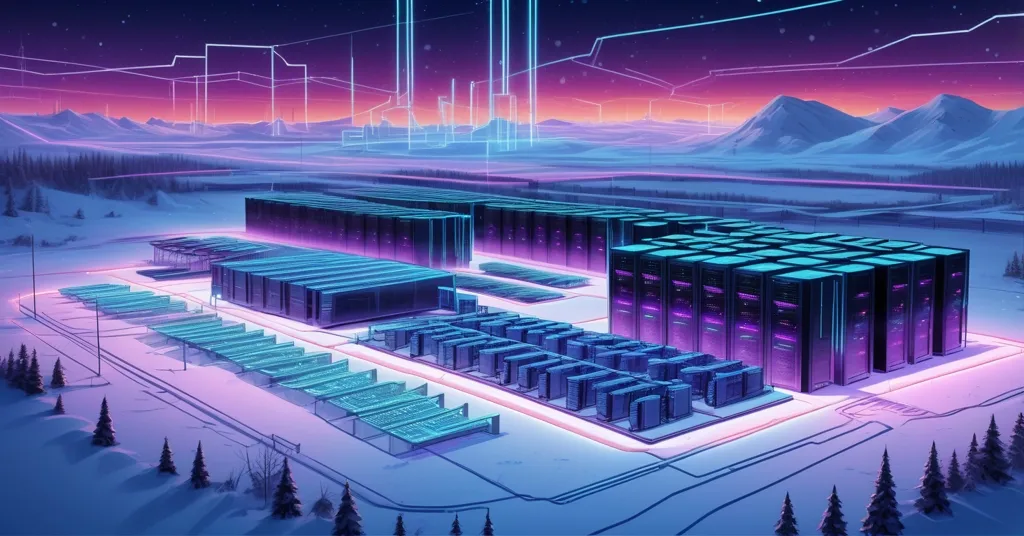Applied Digital Lands $5B AI Lease in North Dakota, Stock Jumps 7% Amid Insider Selling Concerns

Applied Digital Scores $5 Billion AI Lease in North Dakota, Stock Spikes 7%—But Doubts Linger
Applied Digital, a U.S.-based frontrunner in AI infrastructure, has clinched a staggering $5 billion, 15-year lease deal with a major Hyperscaler for its Polaris Forge 2 Campus in North Dakota. This blockbuster agreement, coupled with a 7% stock surge, paints a rosy picture of growth, yet investor skepticism fueled by stock volatility and insider selling keeps the celebration in check.
- Historic Deal: $5 billion lease for 200 MW of AI and HPC infrastructure over 15 years.
- Stock Boost: Applied Digital (NASDAQ: APLD) rises 7%, despite recent 18% tumble.
- Red Flags: Insider selling and AI market jitters temper the optimism.
Let’s unpack this bombshell. Applied Digital has secured a transformative contract with an investment-grade U.S.-based Hyperscaler—think tech titans like Amazon, Google, or Microsoft, though the identity remains under wraps. For the uninitiated, a Hyperscaler is a large-scale cloud service provider that operates massive data networks, often requiring immense computing power for things like AI and machine learning. This particular deal locks in 200 MW of critical IT load and high-performance computing (HPC) infrastructure at the Polaris Forge 2 Campus, a sprawling 900-acre site in North Dakota. HPC, in simple terms, refers to supercharged systems built for heavy-duty tasks like training AI models or crunching massive datasets. What’s more, the Hyperscaler has the first right of refusal—meaning they get dibs on expanding the deal before anyone else—for an additional 800 MW, potentially scaling the campus to a mind-boggling 1 GW. To give a sense of scale, 1 GW could power millions of Bitcoin mining rigs, a comparison that hits close to home for our crowd.
Together with its Polaris Forge 1 Campus, Applied Digital now commands 600 MW of leased capacity across two Hyperscalers in North Dakota. The Polaris Forge 2 site isn’t just about raw size; it’s engineered for efficiency with a target Power Usage Effectiveness (PUE) of 1.18. PUE measures how efficiently a data center uses energy—lower numbers mean less waste, and 1.18 is impressively lean. The campus also boasts near-zero water usage, a critical nod to sustainability as tech giants face heat for their environmental impact. The rollout plan? The initial 200 MW should come online by 2026, with full capacity slated for 2027. If everything pans out, Applied Digital claims this deal bolsters their committed revenue to a staggering $11 billion. That’s the kind of figure that could make even a Bitcoin whale blink twice.
“Our AI Factories are redefining how and where hyperscale infrastructure gets built…We’re demonstrating that the next chapter of AI computing can be powered from the heartland – built responsibly, delivered quickly and designed for the Intelligence Era.” – Wes Cummins, Chairman and CEO of Applied Digital
Wes Cummins is clearly betting big on shaking up the status quo. He’s framing Applied Digital as a trailblazer, using rapid deployment and cutting-edge designs like liquid cooling to outmaneuver rivals. By anchoring these so-called “AI Factories” in North Dakota, they’re flipping the script on the notion that tech innovation must orbit Silicon Valley or coastal hubs. The heartland offers lower costs, abundant energy access, and often less regulatory red tape—factors that could make it a sleeper hit for decentralized tech infrastructure. Sound familiar? It’s the same ethos that drives Bitcoin and blockchain: power shouldn’t be hoarded in a few centralized strongholds, whether we’re talking finance or data centers. North Dakota’s rise could signal a broader decentralization trend, one that might inspire new Bitcoin mining hubs or blockchain projects in unexpected places.
North Dakota: The New Frontier for Tech and Crypto?
Beyond the tech specs, this deal spotlights North Dakota as an emerging hotspot for high-energy innovation. The state’s appeal isn’t just about cheap land; it’s got access to robust energy grids, often tied to renewables or natural gas, which are critical for power-hungry operations like AI data centers—or, for that matter, Bitcoin mining. While Applied Digital is focused on AI for now, as detailed in this report on their $5 billion AI lease deal, the overlap in infrastructure needs is hard to ignore. Both fields demand massive energy inputs and efficient cooling, and we’ve seen companies like Hut 8 or Core Scientific pivot between AI and crypto mining based on market swings. Could North Dakota’s tech boom create ripple effects for decentralized blockchain projects? It’s not a stretch to imagine local economies benefiting from job creation or energy partnerships, much like small Texas towns transformed by mining operations. Though hard data on local impact is scarce, the potential for thousands of jobs and infrastructure investment could be a game-changer for the region.
Investor Jitters: Insider Selling and Stock Swings
Before we start carving statues of Applied Digital’s execs, let’s hit the brakes. Sure, the stock (NASDAQ: APLD) jumped 7% on the news, but it’s been a wild ride lately. Shares recently cratered 18% from over $40 to around $33, including an 8% single-day gut punch. That’s the kind of volatility that’d make a Bitcoin chart during halving season look tame. Worse, insider selling is raising eyebrows. CEO Wes Cummins cashed out 400,000 shares for $6 million, while CFO Muhammad LaVanway dumped 75,000 shares for $1.1 million. That’s over $7 million in exits from top brass—hardly pocket change, and to many investors, it’s a flashing neon sign screaming “buyer beware.” Are they just locking in gains, or do they see cracks in the foundation that public filings haven’t revealed? It’s a question worth chewing on.
Zooming out, the AI sector itself is under a microscope. Analysts are whispering about a potential pullback, with sky-high valuations drawing uneasy comparisons to past tech bubbles—or even the 2017 ICO craze in crypto, where hype outran reality by a mile. Applied Digital’s market position, while strong on paper with $11 billion in commitments, faces fierce competition. Their supposed “moat”—the unique edge keeping rivals at bay—might be more of a shallow ditch in a market where every tech firm is scrambling to build the next data fortress. If Hyperscaler demand falters, or if broader AI spending cools, the fallout could hit hard. It’s not hard to see parallels with crypto’s boom-bust cycles, where overextension often precedes a reckoning.
Crypto Connection: Shared Ground in Decentralized Tech
So, why should Bitcoin and blockchain enthusiasts care about some AI lease in North Dakota? The ties are deeper than they seem. Applied Digital’s push for decentralized tech hubs mirrors the core philosophy of Bitcoin—rejecting over-centralized control in favor of distributed, resilient systems. The infrastructure they’re building, with its focus on energy efficiency and high-density computing, shares DNA with what’s needed for large-scale Bitcoin mining. In fact, the energy debate around AI data centers echoes the flak Bitcoin takes for its consumption, estimated at around 150 TWh annually. Both sectors are wrestling with sustainability, and solutions like near-zero water usage could cross-pollinate.
Historically, some players in this space have flipped between AI and crypto depending on profitability. If AI hype wanes, could Applied Digital pivot part of their capacity to mining during a Bitcoin bull run? It’s not far-fetched—their facilities are already optimized for extreme energy loads. On the flip side, they might be too locked into Hyperscaler contracts to pivot easily, with billions in sunk costs tethering them to AI. Either way, the overlap underscores a broader truth: decentralization isn’t just a crypto buzzword. It’s reshaping tech at every level, from money to megawatts.
Playing Devil’s Advocate: What If the AI Bubble Bursts?
Let’s get contrarian for a second. What if the AI gold rush fizzles out? Market data paints a worrying picture—P/E ratios for AI-linked stocks are often north of 50, a level that screams overvaluation to seasoned investors. If demand tanks, Applied Digital’s $11 billion revenue pipeline could shrink faster than a popped balloon. Unlike Bitcoin, where miners can HODL through bear markets, data center leases are rigid, long-term bets. A pivot to crypto mining might sound neat, but retooling infrastructure isn’t cheap or quick. And let’s not forget competition—every other AI infrastructure firm is eyeing the same Hyperscaler pie. Their growth story is bold, but it’s walking a tightrope over a pit of uncertainty.
That said, we’re still rooting for disruptors like Applied Digital to stick it to Big Tech’s coastal elites. If North Dakota can become a bastion for decentralized innovation, who’s to say it won’t inspire the next wave of blockchain hubs? The heartland uprising isn’t just a cute tagline—it’s a middle finger to centralized power, whether that’s in finance or server farms. But blind cheerleading won’t cut it. The risks are real, and pretending otherwise is how bubbles turn into bloodbaths.
Key Takeaways and Questions
- What does Applied Digital’s $5 billion lease signify for decentralized technology?
It positions them as a heavyweight in AI infrastructure, championing decentralized tech hubs outside traditional centers and echoing Bitcoin’s distributed ethos. - Why is North Dakota becoming a hub for AI and possibly crypto infrastructure?
Affordable energy, lower operational costs, and sustainable designs make it a prime spot for high-energy tech, from AI data centers to potential Bitcoin mining setups. - Should investors be alarmed by insider selling and stock volatility at Applied Digital?
Damn right—dumping over $7 million in shares by executives is a glaring caution sign, though it might just be profit-taking in a frothy market. - How does AI infrastructure intersect with Bitcoin and blockchain tech?
Both rely on massive energy and cooling tech, meaning AI facilities could support blockchain or mining if market dynamics shift, reinforcing decentralization’s reach. - Is the AI market boom sustainable, or are we staring at a tech bubble?
Tough call, but bloated valuations and cutthroat competition mirror past crashes like the 2017 ICO frenzy—proceed with eyes wide open. - Could North Dakota’s tech surge spark a new era for Bitcoin mining hubs?
Possibly, if energy synergies and local investment align, it could draw miners seeking the same benefits Applied Digital tapped for AI—decentralization in action.
Applied Digital’s latest coup showcases the breakneck pace of innovation in tech, much like the wild rollercoaster of Bitcoin’s own journey. But as we’ve learned in crypto, unchecked hype is a recipe for disaster. We’re keeping a sharp eye on this space, applauding the disruption while staying brutally honest about the pitfalls. If they can navigate the storm of AI hype and market doubt, their infrastructure might just lay the groundwork for the next big leap in decentralized tech—be it AI, blockchain, or beyond. Time, and a hell of a lot of energy, will tell.



